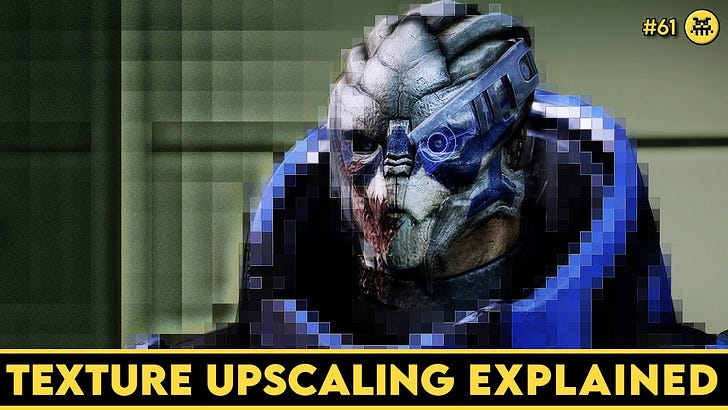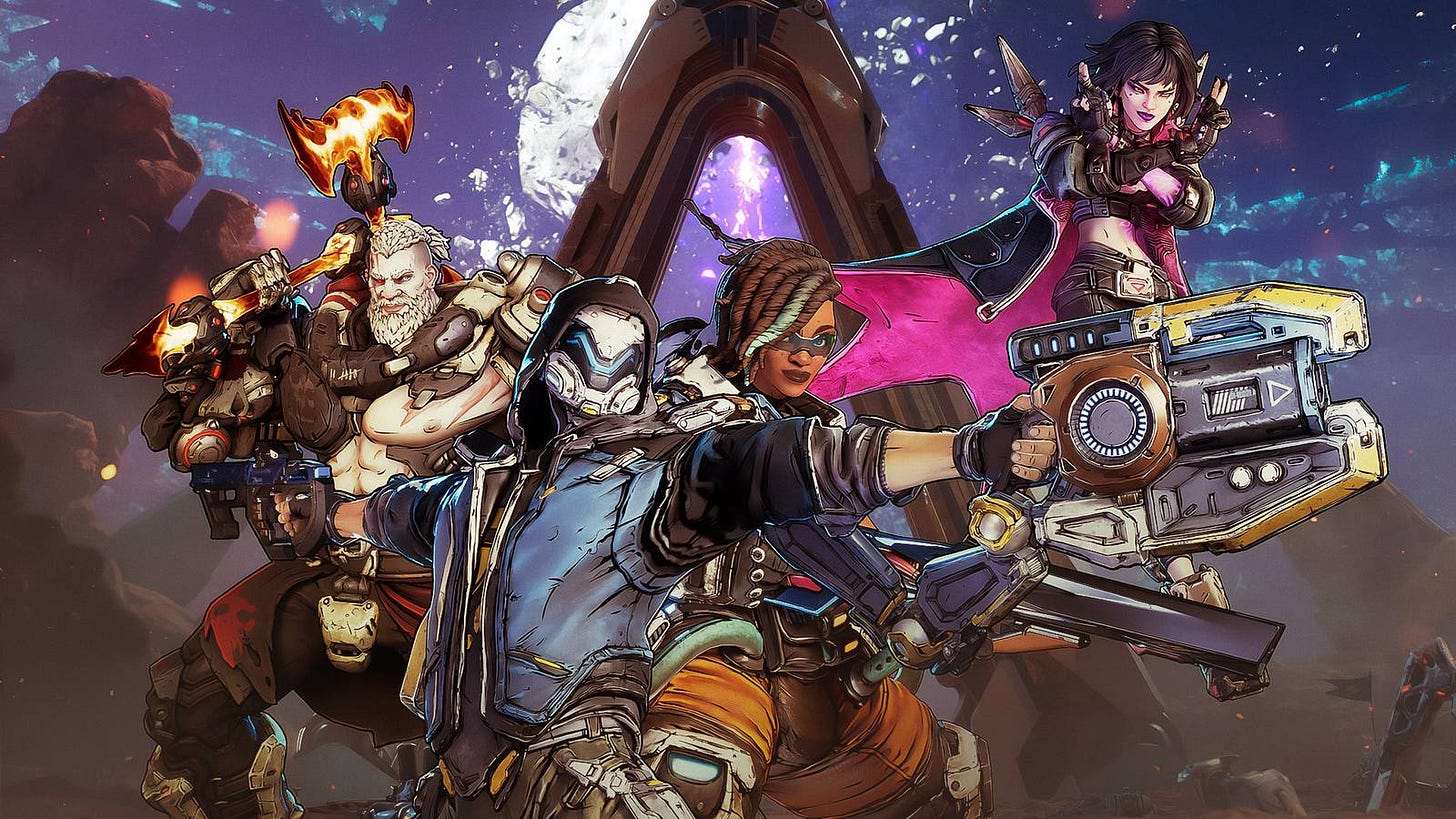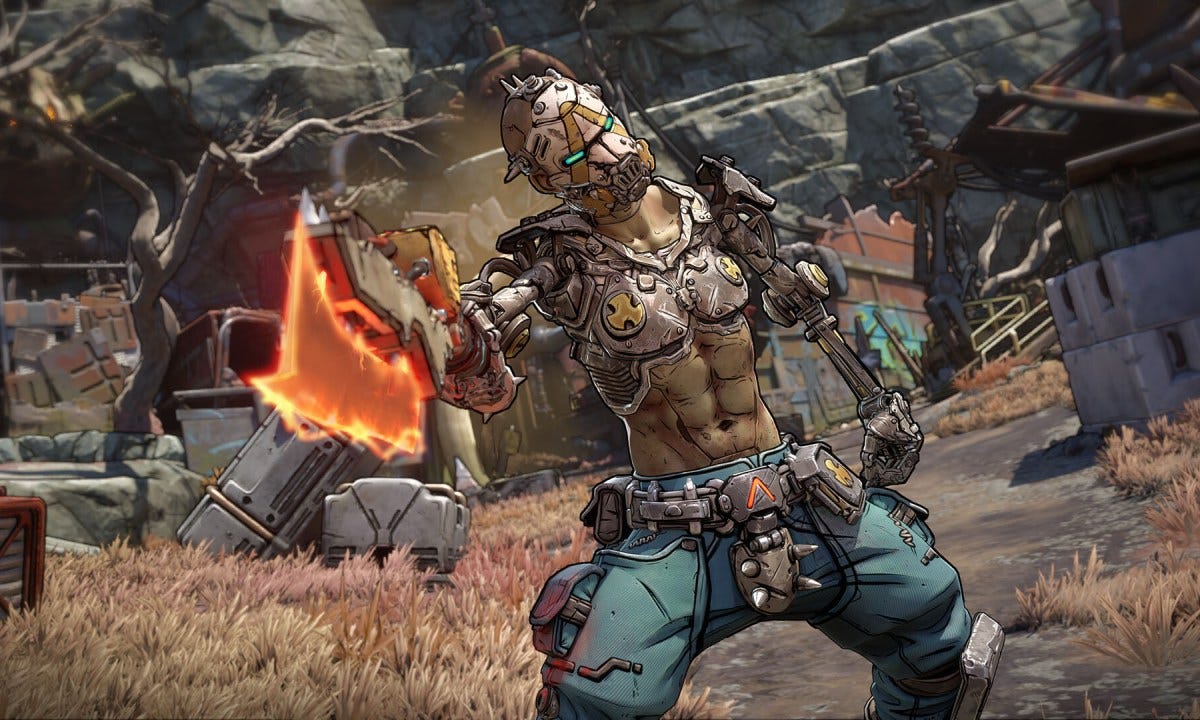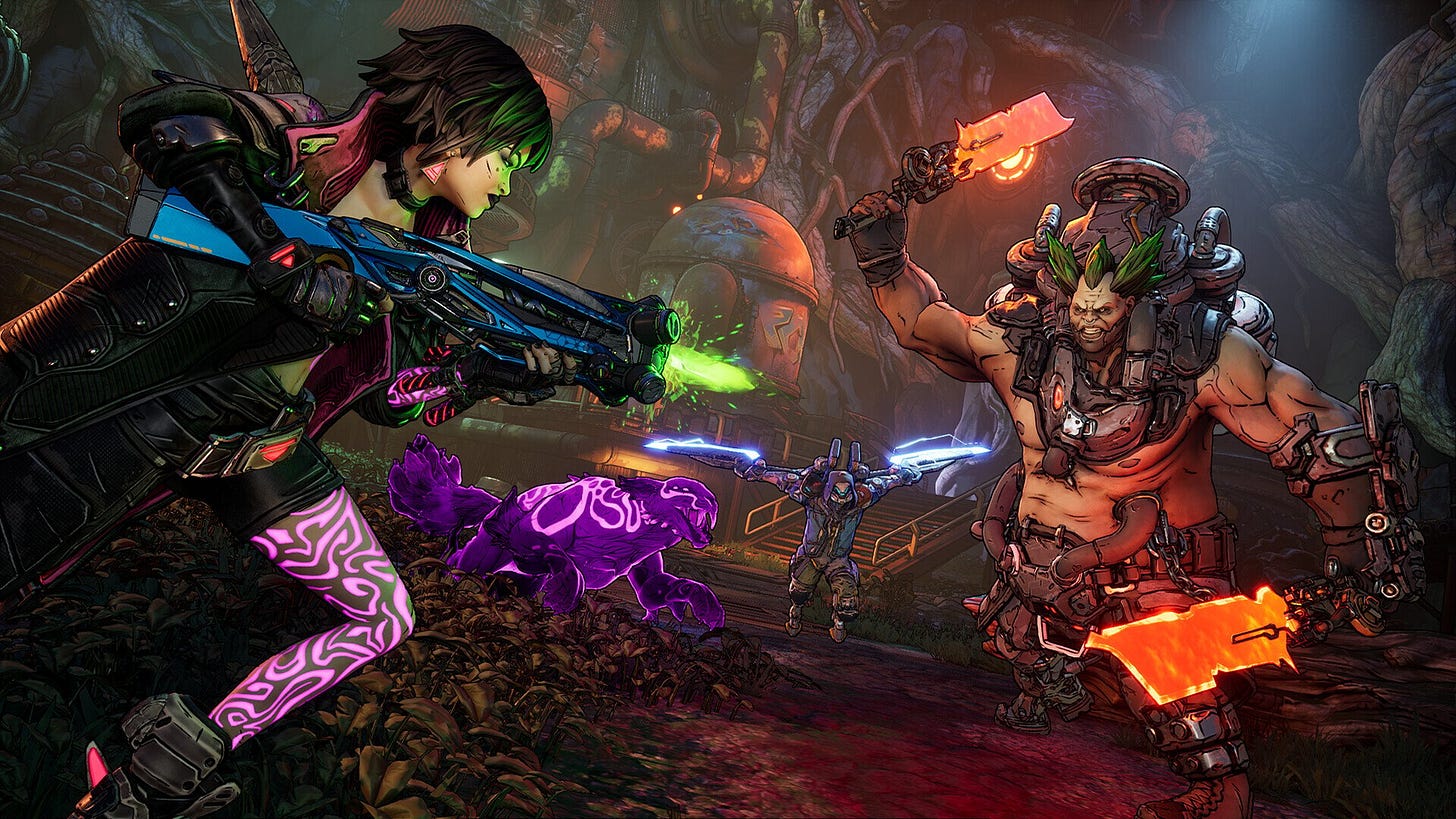The Take: Are AI Rendering Tools Becoming a Crutch?
Borderlands 4 poor performance adds further fuel to brewing consumer frustration.
The performance issues that have plagued Borderlands 4 at launch rely on Nvidia’s DLSS to maintain basic performance.
AI rendering has become normalised within a short span in AAA titles.
A potential shift towards dependency on AI tools for launch windows.
An broader degradation of quality for PC players - while console owners suffer too.
Greetings to The Take, our editorial issues of the AI and Games Newsletter where we dig into the bigger issues impacting artificial intelligence in the video games industry. Issues of The Take are exclusive to premium subscribers of AI and Games.
Hello and welcome to our inaugural issue of The Take!
This is a new series where I get to editorialise a little bit more on the big issues surrounding AI in and around the games industry. For this first issue, I had a bunch of topics from throughout the year I wanted to tackle, but I figured let’s get into something that is current and relevant as the big release window of the year opens up.
Despite strong critical reception, the release of Borderlands 4 has received a lot of criticism from consumers due to performance issues both on PC and console. Critically, the PC version’s optimisation has added sufficient fuel to a brewing frustration among players about the ever increasing use of Nvidia’s AI-rendering technology. Given it’s difficult to play the game with any level of consistency as a result unless you have a very powerful desktop computer.
Follow AI and Games on: BlueSky | YouTube | LinkedIn | TikTok
Another Bajillion Guns…
Gearbox released Borderlands 4 on September 12th to largely positive critical reception: with the sentiment being it’s a return to form and a much needed iteration on the core formula after the lacklustre and cringe-inducing Borderlands 3 in 2019. But outside of the reviews, the narrative surrounding the game at the moment is less about how fun it is to play, but how frustrating it is to try and get it to run with any level of smooth performance.
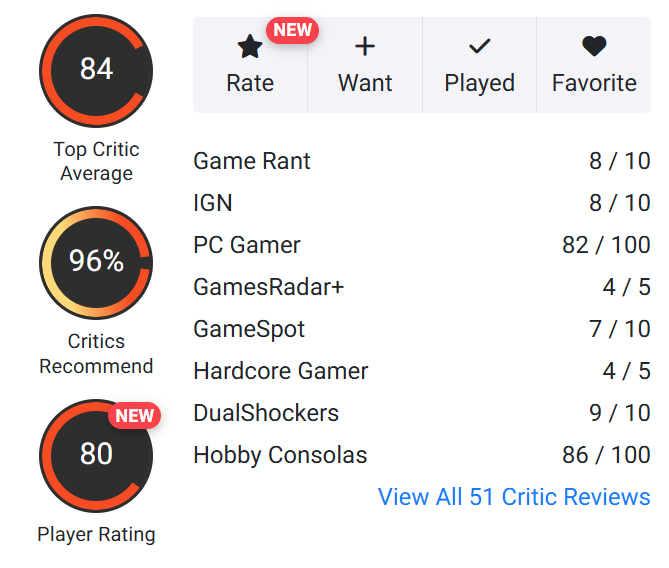
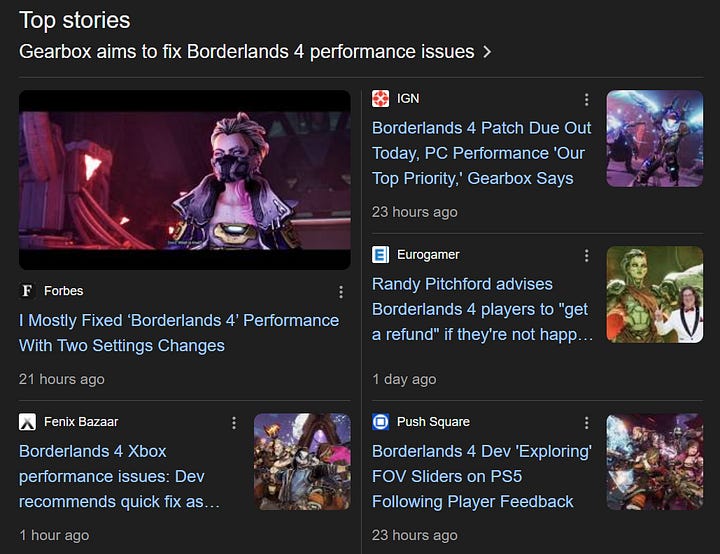
A Year of PC Mishaps: The looter shooter is the latest in a number of high-profile releases in the past year that have suffered from issues at launch on PC. With Alan Wake 2, Monster Hunter Wilds, Rise of the Ronin, Wolong Fallen Dynasty and even just last week analysis of Dying Light: The Beast suggests that the game does not perform well out of the gate.
Now it’s worth making the all important caveat that shipping games to PC is a significant challenge. Speaking from experience, shipping to PC means you’re dealing with a wide variety of motherboards, CPUs, GPUs and memory profiles that means issues may only impact a specific contingent of players who have a particular hardware make-up (or even the drivers for said hardware). While satisfying console certification on the likes of PlayStation, Switch, and Xbox is a challenge, the one benefit is that the hardware profiles are static - even if it means fighting around shipping on the low-powered Xbox Series S.
But the bigger issue that’s brewing is that in many instances, the suggestion from studios is to rely on real-time AI-powered upscaling technology as a means to smooth out the performance. If you’re not familiar, most AAA games now support the likes of AMD’s FixelityFX Super Resolution (FSR) or Nvidia’s Deep Learning Super Sampling (DLSS) as part of the graphics features. These are AI-supported development tools that allow for you to run a game at a higher resolution - and even frame rate - than your device can support, by relying on the AI processing cores now built into contemporary GPUs.
DLSS All Day, Every Day: The furore surrounding Borderlands 4 has been exacerbated by the game more or less requiring the use of Nvidia’s DLSS at launch in order to have even close to a stable performance even on lower spec devices. Nvidia provided a full-suite of recommendations for various hardware profiles, which has received significant ire from players when it was noted that regardless of setting, you should - in the eyes of Nvidia anyway - be running the game with DLSS enabled.

So what’s going on here? Well, there’s a bunch of issues happening at once:
A push for AI upscaling to transition from a feature, to a requirement.
An inflection point with consumers frustration with AI rendering.
A culmination of years of brewing discontent.
Poor communication from studios on how to address the issues.
Gearbox being a serial offender in this instance.
A growing disparity in quality of console vs PC launches.
Though even the console versions of Borderlands 4 have their problems.
A market cannibalising its audience, as PC gamers have to keep up with inconsistent hardware requirements. Meanwhile consoles no longer provide the accessible entry point they once did.
In Defence of Developers
Before we get into the weeds on this, I want to present an important caveat: these issues don’t arise because game developers are ‘lazy’ or other similar narratives. Games have launch dates, games have complex partnership agreements and business arrangements, and it’s expected that they hit those dates and satisfy those contracts. It is the studio management in conjunction with the publisher that decides how and when a game launches - plus 101 broader issues that come down to money already being spent to get the game marketing machine underway, to simply launching before the end of a fiscal year.
So it’s important to remember all of this is the result of business decisions being made at senior levels over whether the product is in an acceptable condition to put to market. Some ‘fans’ are quick to point the blame at the people actually doing the work, which unless they’re a studio of a handful of people, I’m willing to bet they had zero say in those decisions. So yeah, a shout-out to all the devs at Gearbox and everywhere else who have have fought these issues before or are fighting them now.
AI Rendering: A Quick Overview
Let’s take a moment to summarise what we mean by AI rendering, or more specifically neural rendering, and how this has become normalised in recent years. Traditionally graphics rendering takes the instructions coming out of the render pipeline of the game engine and pumping that into the graphics card (GPU). The output then being rendered directly at the screen. However more recently, neural rendering has become increasingly popular, where it acts as an intermediary between the GPUs processing, and the players visualised output.
For this section I will refer to this technique as ‘neural rendering’ - because that’s what it is - but I revert to ‘AI rendering’ for the remainder of the article.
AI Delivering the Finishing Touch: Neural rendering is an alternative approach that typically takes a hybrid of traditional rasterisation methods with an AI system that enables for an increase in overall visual fidelity. The term is used given we typically rely on artificial neural networks and train them to achieve very specific tasks. These tasks typically boil down to one of two things:
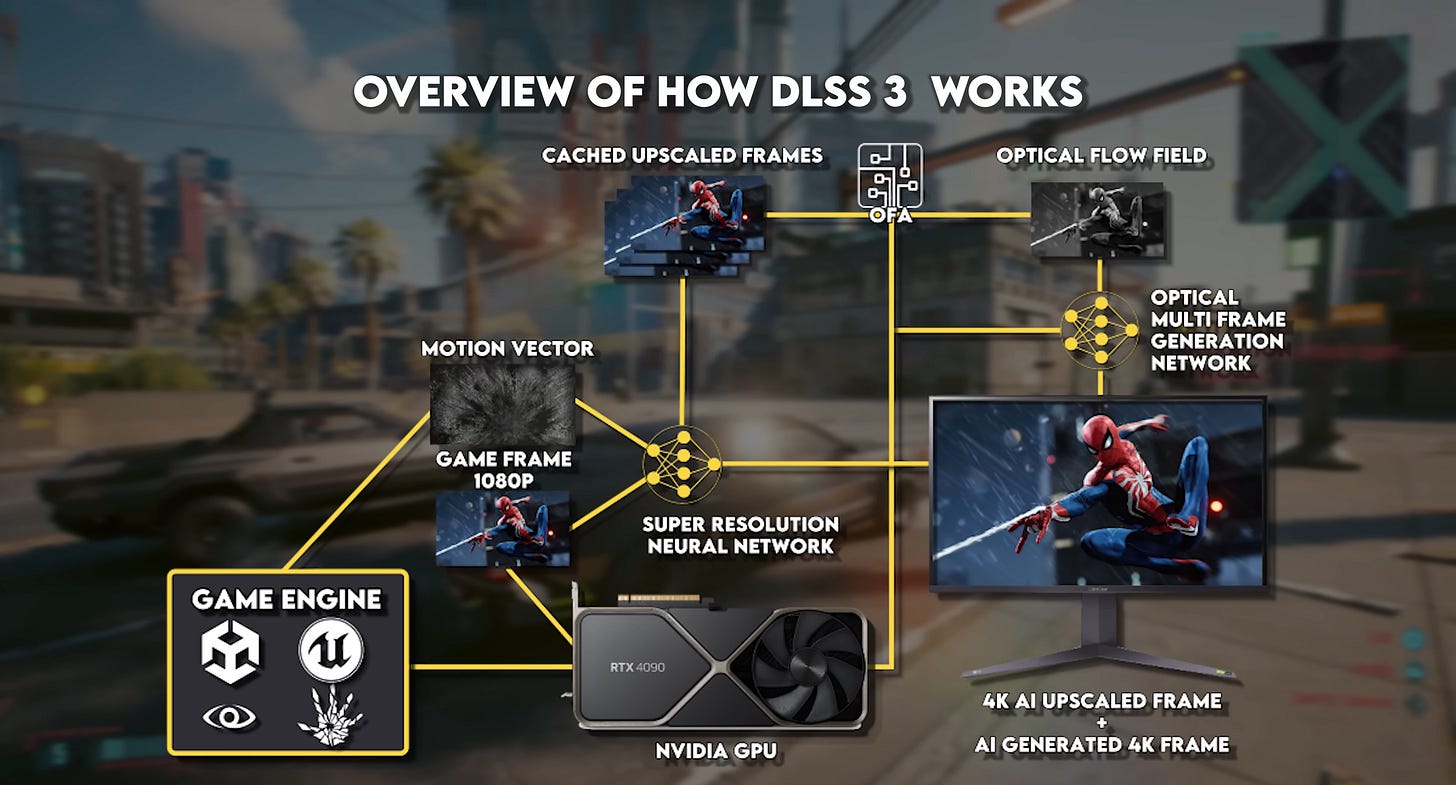
Increased Resolution: An image can be recreated at a higher resolution than normal courtesy of a neural upscaling feature. This can be on a per-texture level, or the entire visual frame. Moving from the likes of 720 or 1080p up to 1440p or 2160p.
Increased Frame-Rate: Interpolating intermediate frames that should occur from the graphics card by examining previous frames.
The former has been achieved either on a per-game basis or on the platform hardware. A couple years back we talked about the rise of AI-powered texture upscaling that originated in modding communities by putting old game textures through the likes of Generative Adversarial Networks (GANs), a form of generative AI that tries to create facsimiles of original content. This was later adopted in the likes of Mass Effect Legendary Edition to upscale from 720p to 4k resolution. However this was done offline; the textures were upscaled using AI during development and it didn’t occur at runtime - with many still requiring manual cleanup.
In more recent years we’re seeing the upscaling happen in real-time. While the one notable example for an individual game is God of War: Ragnarok, which uses neural rendering to upscale textures during play from lower to higher resolutions as a means to minimise install space on the hard drive. Though we largely think of this now with the likes of Nvidia’s DLSS and AMD FSR techniques (which require the associated GPU to operate). These are updating in real-time based on the output of the render of the game. The game is rendered at a lower resolution than intended, and then upscaled using the neural rendering technique to get it to the target specification.
In addition since Nvidia released DLSS3, they have also provided the means to render intermediate frames of a game. This has since been separated out into a distinct feature, with DLSS providing the upscaling and ‘AI frame generation’ being a separate tool that requires DLSS to be enabled to operate.
Pros and Cons
Neural rendering has had a mixed reception among consumers in the past couple of years. There are advocates and critics all around, and it falls under a number of key aspects:
Pro - Higher Resolution at Lower Cost: The original intent of DLSS as it was sold to consumers was that it enables for someone with a lower hardware profile than necessary to render a game at 4K can do so provided they have a compliant GPU.
Con - Ghost in the Shell: Despite this gain in resolution, it has been noticed in various circumstances that DLSS is not perfect. It creates blurring in some textures, plus artefacts and ghosting in the output in fast paced games.
Pro - Increase in Frame Rate: The use of the AI frame generation now means that players can move towards playing their games at a more consistent 40-60fps, which is increasingly a standard in PC gaming.
Con - The ‘Fake Frame’ Debate: The problem is AI frame generation doesn’t increase the frame rate of the actual game engine. It’s rendering intermediate frames outside of the engine. This means the game renders at a higher frame that it plays, and sometimes even leads to input lag and latency in the likes of DLSS3.
Pro - Playing Games on New Platforms: The Nintendo Switch 2 is the first of the main games consoles that enables for DLSS out of the box. This allows for games such as Cyberpunk 2077 to run on the hardware, given it more or less requires it at all times.
Con - Forced Implementation: The Switch 2 port of Cyberpunk 2077 is a great example of where the game needs DLSS to run. You can’t turn it off on the hardware regardless. And that speaks to a brewing tension with consumers.
Con - Misrepresentations of Performance: The use of DLSS has lead to consumers questioning the optimisation made for specific games. Accusations are being raised that rather than relying on traditional rendering techniques to optimise key parts of game scenes (e.g. using a hybrid of ‘baked’ and real-time lighting), developers are using DLSS as a means to side step these optimisation steps, which typically means games will run poorer on lower-end hardware.
And it’s this last issue that’s really the crux of the Borderlands 4 situation.
An Over-Reliance on AI-Rendering?
The frustration surrounding the continued adoption of AI rendering like DLSS and FSR is that it suggests that in more and more cases the end-consumer is receiving a poorer experience at launch. Given the game is not well optimised for lower-end hardware, and meaning you have to run DLSS to get it to run at all. This is rather at odds with how it was originally marketed: as a means to achieve better performance with lower end hardware.
The Death of Optimisation?: The Borderlands 4 launch debacle speaks to the gradual shift in how games are releasing on PC without the necessary optimisations not just for lower-end hardware, but higher end too. I mean I can speak to this from some experience having played a bit of Borderlands 4 at launch. I run an Intel i9-10900X (3.7GHz) with an Nvidia RTX-4090 and 96GB of RAM, and yet I’m somehow seeing frame drops and hitches when attempting to run at 60fps on 2160p resolution - both with and without DLSS and frame generation. This gets smoothed out somewhat with DLSS enabled. But this speaks to the issue at large: why can’t I run a game smoothly with what is still in a beast of a machine in 2025? Particularly when you consider the base level of consumer hardware, and the static nature of console specifications.
Footage of Borderlands 4 | 2160p resolution 60fps | native rendering.
Most Players Don’t (Or Can’t) Play in 4K: The interesting part looking from the outside-in, the thing that only reinforces this frustration, is that most players can’t play games in 4K. Even the most recent Steam hardware survey published in August of 2025 shows that while Nvidia is the most publisher GPU provider (75% adoption), with the RTX 4060 the most popular graphics card (at 4.6% adoption), players still for the most part render games at 1080p with 54% of participants playing at that level. Around 30% of consumers have a primary monitor resolution higher than 1080p, with only 5% of consumers render their games at native 4K resolutions (i.e. 2160p or higher). So at this time using DLSS for its original intent of running games in 4K resolution isn’t even an option for 50% of the Steam-playing population who have 1080p monitors. But is becoming a requirement for them to run their games at the same resolution.
Footage of Borderlands 4 | 2160p resolution 60fps | DLSS + frame gen
GPUs Increase in NPU Capacity, But Not VRAM: All of this plays alongside an issue that recent updates to Nvidia GPU’s are focussed less on increasing the GPU clock speed and VRAM - which would enable for faster native performance without DLSS. But instead with significant increase to the NPUs (neural processing units) that allow for AI rendering to become more commonplace. Which largely aligns with Nvidia’s broader push to become an AI company rather than a GPU business. In fact earlier this year Nvidia announced that around 80% of their RTX GPU users now use DLSS - which is both a sign of their efforts to push the technology, plus the reliance for people to need to use it to get stable performance.
More SKU’s, More Problems
It’s also worth stressing that these issues do not stop at Borderlands 4’s PC version. In fact players have noticed the console versions gradually degrade in performance over time. Now neither the Xbox Series S | X or PlayStation 5 (Pro) rely on Nvidia’s AI rendering technology. In fact the only one of these systems capable of any super resolution is the PlayStation 5 Pro, which runs its own proprietary PlayStation Spectral Super Resolution (PSSR) technology.
Consoles Sprung a Leak: Right now the suggestion is that the console versions have a memory leak in them - which for non-programmers means a part of the game code is retaining memory when it should release it, and over time it will gradually ‘leak’ the available memory from the system. This seems to be corroborated by the current suggestion by Gearbox to kill the game and restart it periodically - which will reset all the memory previously assigned to the active game.
Now while this issue only seems to exist on the console builds, it does reinforce the broader concern that the game is not sufficiently optimised and has been somewhat rushed to market. In fact just this morning as I was finishing writing this up came word that the Switch 2 port of the game has been delayed indefinitely - simply adding fuel to this fire.
A New Era of PC Market Mishaps
As mentioned at the top of the article we’re in an age where PC games are launching in a bit of a sorry state, and then the solution is to work to correct it over time - and hope those issues are not sufficient to derail the goodwill of the playerbase in the process. But this isn’t the first time we’ve gone through this headache, but it’s largely for very different reasons.
The Old Era of Poor PC Ports: If you wind the clock back to the late 2000’s through to the mid 2010’s, PC was treated as an afterthought by many of the larger publishers out there given console was the dominant sales platform for most big releases. This led to all sorts of disastrous ports that suffered from a number of issues. With The Evil Within being so poorly optimised to run on PC hardware it was capped at 30fps with a letterbox view, to Dark Souls: Prepare to Die Edition lacking meaningful features and modifications to support PC users. The worst culprit being Batman: Arkham Knight which was riddled with so many issues from top to bottom it completely killed any further momentum for the game - and it was pulled from Steam for a time until it was fixed.
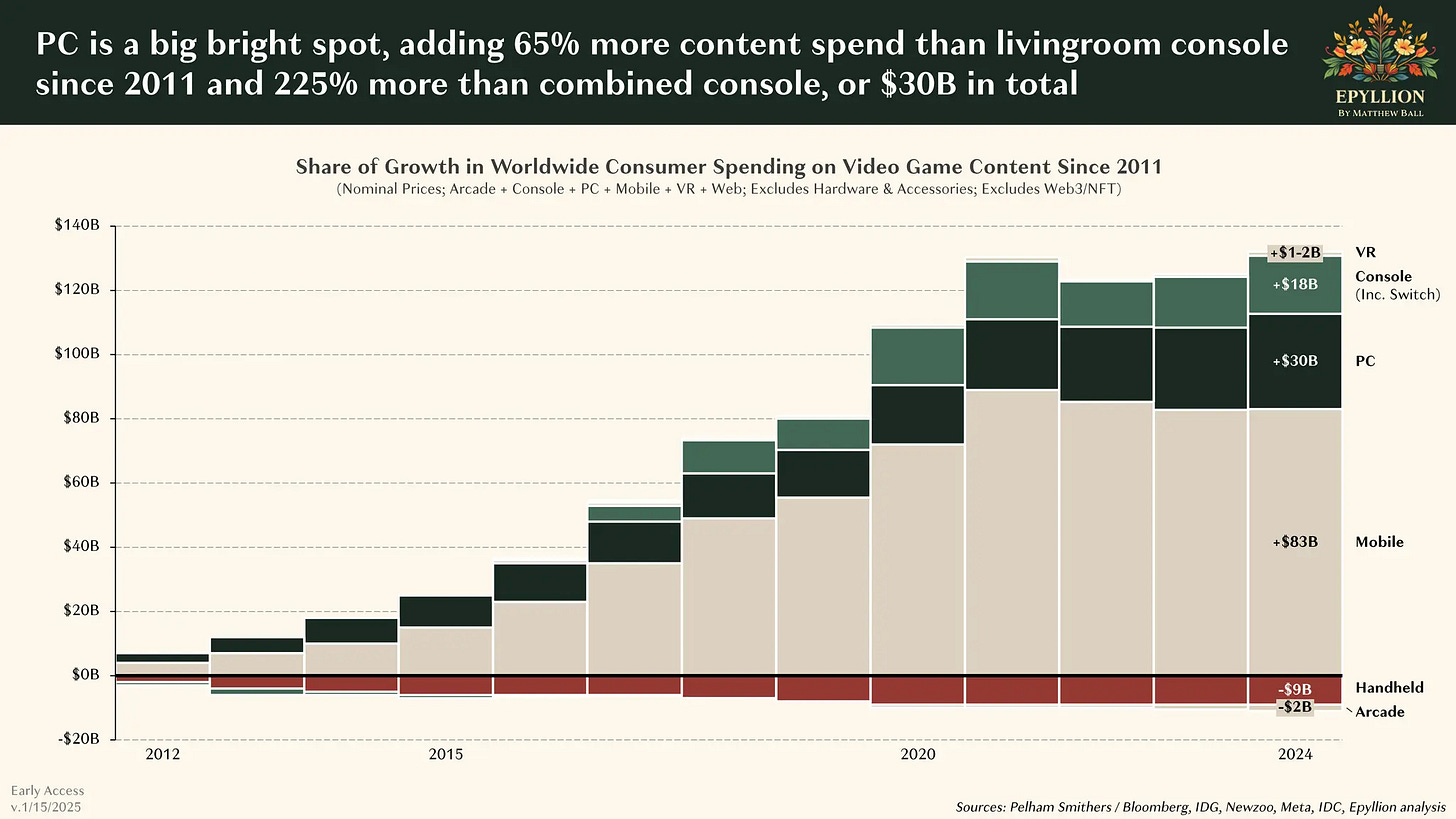
These issues came at a time where PC was simply not considered as important as say the Xbox 360 / Xbox One or PlayStation 3 / PlayStation 4 for making their money. A failure to grasp the growing PC market that has since surpassed consoles as the largest growth sector outside of of mobile gaming.
The Growing Disparity Between PC and Console: This perceived lack of PC optimisation also speaks to a concern of where resources are being spent. Consoles are fixed platforms - their hardware profiles are consistent until the next version comes out. Plus the Xbox and PlayStation cannot rely on AI rendering techniques to gloss over the issues. Are we returning to the era of the PC port being the afterthought given the consoles need more optimisation to run smoothly?
Gearbox Only Making Matters Worse
With DLSS becoming increasingly normalised, and Borderlands 4 essentially reliant on it to have any kind of consistent performance, right now it would make sense for Gearbox to keep their head down and get on with addressing the known performance issues - and to their credit the studio have been doing that.
But that didn’t stop their CEO Randy Pitchford’s return to form and antagonise the customer base. Stating that the game is “running pretty optimally” on Twitter, and that players should use DLSS by default.
He has since encouraged people to get refunds if their not happy, and or just “code your own engine” if you’re not happy.
Randy, Maybe… Just Stop Talking: This is of course not the first time Pitchford’s comments have got him, his company, and the products associated with them in hot water. Whether it’s his defence of the poorly received Aliens: Colonial Marines where he blamed consumers for having high expectations, or his legal troubles that were made public during the press rounds of Borderlands 3. But his recent comments have simply dumped a whole lot of fuel to a simmering fire.
The Balance is Fractured
I wanted to end this piece by making a very specific point. The hardware ecosystem for non-mobile gaming that has existed for quite some time now in the games industry has been predicated on two key aspects:
PC gaming gives consumers freedom to play at the quality they can afford.
Consoles act as an accessible and stable tentpole.
It Can Play Crysis: For much of the past 20-ish years PC players have had the freedom to optimise their builds based with some confidence in results. Recent PC games suggest this is no longer the case. It’s difficult to ascertain whether or not a player can achieve base levels of performance at current conventions of 1080p resolutions with a 60fps frame rate, and that’s even with DLSS enabled.
DLSS vs Traditional Optimisation: It feels more and more like DLSS is the immediate go-to solution versus traditional optimisation of a title. Given that Nvidia is partnering with studios and will be working with them to ensure DLSS is working for the title, it feels like this is where the resource is being spent rather than fixing the UE5 hitches that Borderlands may well be suffering from.
What Was Once Support is Now Required: This push towards using AI rendering to work around optimisation is very much the antithesis of how DLSS was originally advertised to players. As mentioned earlier DLSS was originally sold as a means to help them get that extra boost in visual quality. To help them get to play their game at a level a level bit higher than their existing hardware could attain using traditional rendering. With the Borderlands 4 information from Nvidia, it’s now a requirement more or less to use it regardless of hardware profile.
Who Are We Targeting?: A big question for me is the desire to push for richer and more complex 4K rendering has lead to us creating games where the hardware profiles are next to impossible to attain. Who are we targeting here? A generation or two ago we had the opposite problem with poor PC ports, given the expectation was the consoles dictated expectations of visual fidelity. Now it strikes me there is no clear idea as to who the target audience is, and what their hardware profiles look like. All the while the hardware required is becoming more expensive.
A Small Improvement: I mean I’ll concede this a rather petty point. But I’m not seeing what significant improvements exist in the visual fidelity of Borderlands 4 to warrant all of these headaches. Borderlands 3 largely looked fine, and a game such as this with a cartoon style isn’t needing a huge push to improve the gameplay.
Degradation of Quality, Regardless of Platform: Now the baffling thing here is that this is pushing PC users into bigger and more expensive hardware loads to try and get close to a stable performance, and yet their setups now vastly exceed games consoles that simply cannot keep up. Yes it is to be expected that if you want games looking bigger and better than ever, you won’t get that happening on a PS5 Pro, but rather you’ll go build a desktop. Surely this causes issues both on consumer and developer side where the game is increasingly fractured to handle performance - with the disparity between console and PC ever increasing and yet nobody is having a good experience.
The Future of Console Gaming: As I’ve eluded to before, AI rendering is coming to consoles. It’s already on Switch 2, and the next PlayStation and Xbox will also cater to it. Are we going to see an entire generation of DLSS-always-enabled titles coming to these platforms if no clear PC targets are being established?
Side Note - Console Accessibility is Dying: A small sidebar, in that if consoles are going this route the compromise is no longer really evident. We know that consoles are often the entry point for consumers, often at the expense of greater fidelity and customisation, but they were reliable. But that reliability has to go hand-in-hand with them being accessible, and with the current economic market pushing games consoles to become increasingly more expensive, we now have console products that potentially deliver inferior product, and cost more with little to show for it.
Closing
Whether the studio likes it or not, Borderlands 4 has become the poster child of the optimisation argument that has been brewing in the games industry over the past year or two. As we see the use of AI-rendering DLSS becoming increasingly commonplace in PC launches, I suspect we will see similar motions in console spaces. With Switch 2 games requiring it by default. Meanwhile the next generation of Xbox and PlayStation consoles will no doubt start providing FSR features on titles given both have announced their continued reliance on AMD chipsets in the future.
But for now, it strikes me that there are two immediate concerns for the industry to address:
Games studios need to be thinking about the negative impact that reliance on AI rendering is having on consumers. We’re experiencing a paradigm shift that thus far seems to provide little benefit - even to those it was originally advertised towards.
Someone needs to tell Randy Pitchford to keep his mouth shut.




